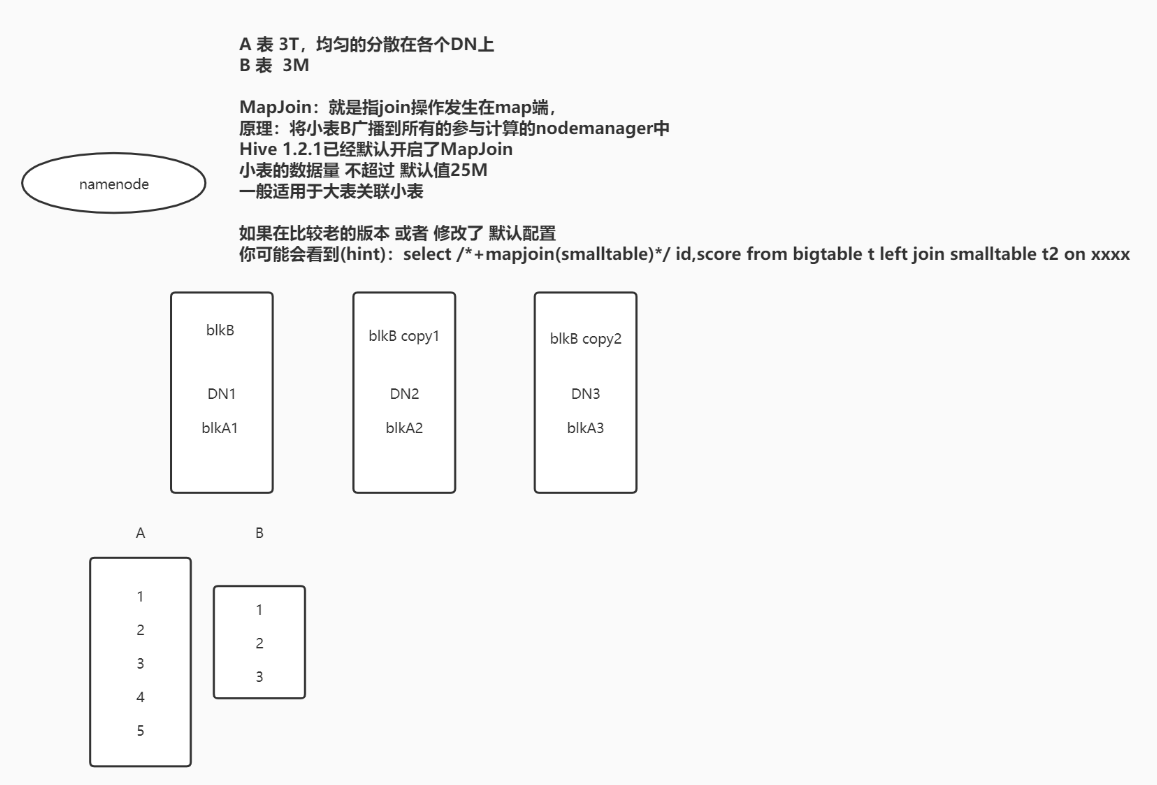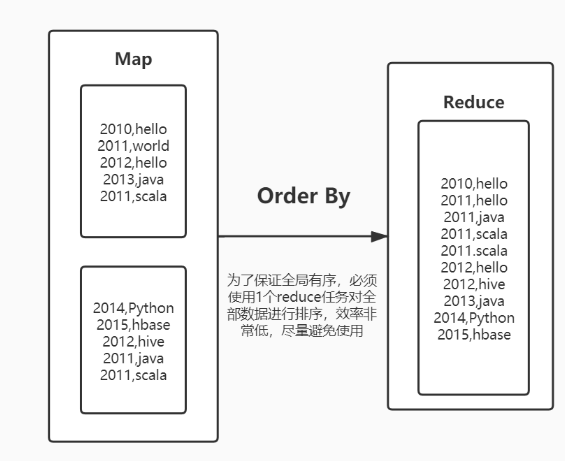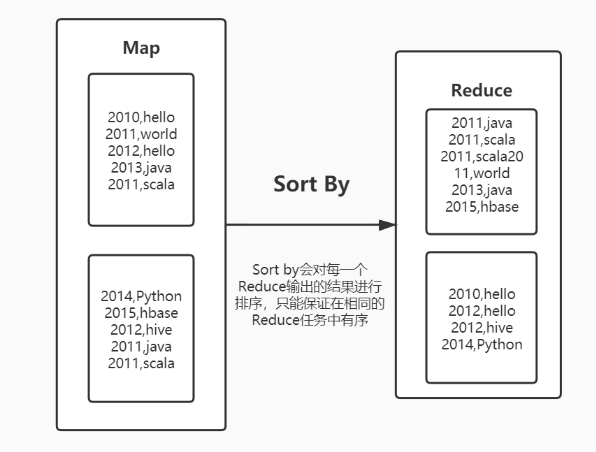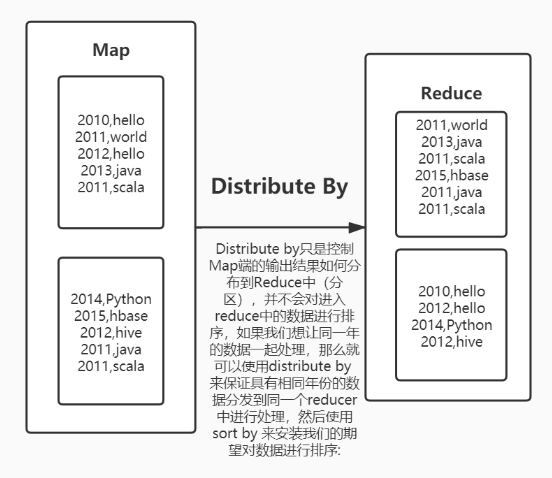Hive 的数据类型、HQL
SQL练习
1、count(*)、count(1) 、count('字段名') 区别
2、HQL 执行优先级:
from、where、 group by 、having、order by、join、select 、limit
3、where 条件里不支持不等式子查询,实际上是支持 in、not in、exists、not exists
-- 列出与“SCOTT”从事相同工作的所有员工。
select t1.EMPNO
,t1.ENAME
,t1.JOB
from emp t1
where t1.ENAME != "SCOTT" and t1.job in(
select job
from emp
where ENAME = "SCOTT");
7900,JAMES,CLERK,7698,1981-12-03,950,null,30
7902,FORD,ANALYST,7566,1981-12-03,3000,null,20
select t1.EMPNO
,t1.ENAME
,t1.JOB
from emp t1
where t1.ENAME != "SCOTT" and exists(
select job
from emp t2
where ENAME = "SCOTT"
and t1.job = t2.job
);
4、hive中大小写不敏感
5、在hive中,数据中如果有null字符串,加载到表中的时候会变成 null (不是字符串)
如果需要判断 null,使用 某个字段名 is null 这样的方式来判断
或者使用 nvl() 函数,不能 直接 某个字段名 == null
6、使用explain查看SQL执行计划
explain select t1.EMPNO
,t1.ENAME
,t1.JOB
from emp t1
where t1.ENAME != "SCOTT" and t1.job in(
select job
from emp
where ENAME = "SCOTT");
# 查看更加详细的执行计划,加上extended
explain extended select t1.EMPNO
,t1.ENAME
,t1.JOB
from emp t1
where t1.ENAME != "SCOTT" and t1.job in(
select job
from emp
where ENAME = "SCOTT");
Hive数据类型
hive读时模式,在读取数据的时候,如果没有数据或者数据的类型不匹配,会显示null
表的结构统称 schema
整型:TINYINT、SMALLINT、INT、BIGINT
TINYINT — 微整型,只占用1个字节,只能存储0-255的整数。
SMALLINT– 小整型,占用2个字节,存储范围–32768 到 32767。
INT– 整型,占用4个字节,存储范围-2147483648到2147483647。
BIGINT– 长整型,占用8个字节,存储范围-263到263-1。
浮点:FLOAT、DOUBLE
FLOAT– 单精度浮点数
DOUBLE– 双精度浮点数
布尔类型:BOOLEAN (False/True)
TRUE/FALSE
字符串:STRING
STRING– 不设定长度
时间类型:
-
时间戳 timestamp
Timestamp 格式 “ YYYY-MM-DD HH:MM:SS.fffffffff ”(9位小数位精度)
-
日期 date
Date DATE值描述特定的年/月/日,格式为YYYY-MM-DD
create table testDate(
ts timestamp
,dt date
) row format delimited fields terminated by ',';
// 2022-02-19 14:24:57.200,2022-02-19
-
时间戳与时间字符串转换
from_unixtime() -- 时间戳→字符串
unix_timestamp() -- 字符串→时间戳
// from_unixtime 传入一个时间戳以及pattern(yyyy-MM-dd) 可以将 时间戳转换成对应格式的字符串
select from_unixtime(1630915221,'yyyy年MM月dd日 HH时mm分ss秒')
// unix_timestamp 传入一个时间字符串以及pattern,可以将字符串按照pattern转换成时间戳
select unix_timestamp('2021年09月06日 16时00分21秒','yyyy年MM月dd日 HH时mm分ss秒');
select unix_timestamp('2021-01-14 14:24:57.200')
复杂数据类型:
-
array
数组 有索引
create table testArray(
name string,
weight array<string>
)row format delimited
fields terminated by '\t'
COLLECTION ITEMS terminated by ',';
select name,weight[0] from testArray;
杨老板 140,160,180
张志凯 160,200,180
row format delimited fields terminated by '\t' -- 指定列分割符
COLLECTION ITEMS terminated by ',' -- 指定数组中元素的分割符
weight[0] -- 通过索引获取元素
-
map
key:value,key2:v2,k3:v3
create table scoreMap(
name string,
score map<string,int>
)ROW FORMAT DELIMITED
FIELDS TERMINATED BY '\t'
COLLECTION ITEMS TERMINATED BY ','
MAP KEYS TERMINATED BY ':';
select name,score['语文'] from scoreMap;
小明 语文:91,数学:110,英语:40
小红 语文:100,数学:130,英语:140
MAP KEYS TERMINATED BY ':' -- 指定 K V 之间的分割符
score['语文'] -- 通过对应的K获取V
-
struct
结构体 -- 自定义一些属性
create table scoreStruct(
name string,
score struct<course:string,score:int,course_id:int,teacher:String>
)ROW FORMAT DELIMITED
FIELDS TERMINATED BY '\t'
COLLECTION ITEMS TERMINATED BY ',';
select name,score.course,score.score from scoreStruct;
小明 语文,91,000001,余老师
小红 数学,100,000002,体育老师
score.course -- 通过 字段名.属性 来获取元素
Hive HQL
类SQL语言 -- 绝大多数命令与SQL类似
DDL -- 数据定义语言
DQL -- 数据查询语言
DML -- 数据处理语言
DCL -- 数据控制语言
DDL
default库 -- /user/hive/warehouse 在hdfs上的目录
删除库时若该库中有表 -- 级联删除 drop database 库名 cascade;
查看当前所在的数据库 select current_database(); --这里和MySQL中不一样
创建数据库 create database xxxxx;
查看数据库 show databases;
查看当前所在的数据库 select current_database();
删除数据库 drop database tmp;
强制删除数据库:drop database tmp cascade;
查看表:SHOW TABLES;
查看表的元信息:
desc test_table;
describe extended test_table;
describe formatted test_table;
查看建表语句:show create table table_XXX
重命名表:
alter table test_table rename to new_table;
修改列数据类型:alter table lv_test change column colxx string;
增加、删除分区:
alter table test_table add partition (pt=xxxx)
alter table test_table drop if exists partition(...);
DQL
HQL 执行优先级:from、where、 group by 、having、order by、join、select 、limit
select id,name from tb t where ... and .... group by xxx having xxxx order by xxx asc/desc limit n;
-
where :过滤数据、!!!分区裁剪!!!
-
distinct:去重
-
join:left join、right join、join 注意MapJoin

-
group by : 通常结合聚合函数一起使用
-
order by:全局排序

-
sort by:局部排序

-
distribute by:分区

-
cluster by = distribute by + sort by

https://zhuanlan.zhihu.com/p/93747613 order by、distribute by、sort by、cluster by详解





